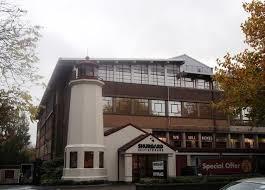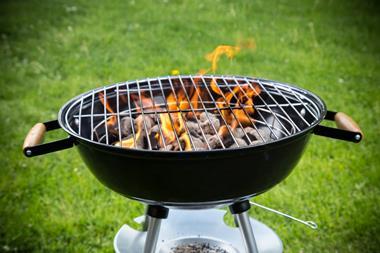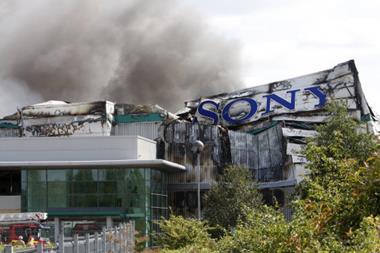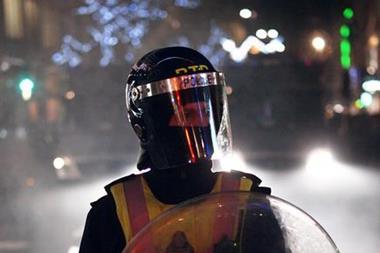Zurich’s claims data shows the average cost of large warehouse fires is £5.9m
Zurich has warned of a potential increase in warehouse blazes as the pandemic-propelled e-commerce boom has sparked a surge in demand for storage and distribution space.
The insurer pointed out that outdated rules on sprinklers could fuel an increase in warehouse blazes, harming businesses and the economy.
Statistics from the Home Office covering all 44 fire authorities in England between April 2019 and March 2020 showed that the number of warehouses gutted by fire had increased by 42% between 2019 and 2020.
The figures also revealed that retailers were scrambling to secure more warehouse units, with demand for sites over 100,000 square feet up by 64% last year, as the pandemic accelerated the shift to online shopping.
This has led to renewed calls for automatic sprinkler protection to be made compulsory in all new warehouses over 2,000 square metres, which is roughly a third of the size of a football pitch.

Charles Bush, Zurich’s head of property and energy claims, said: “Warehouses underpin the huge and growing e-commerce sector. Against the tens of millions of pounds Britons spend online every day, current sprinkler standards look increasingly inadequate.
”As well as posing a threat to life, warehouse blazes devastate businesses, send shockwaves down supply chains and lead to the loss of jobs and productivity.”
Size matters
The growth in online retail has also sparked a trend towards using taller and larger “big box” warehouses, with goods being more tightly packed.
In addition, automation - including the use of robots - has heighted risk factors, subsequently increasing the costs around warehouse fires.
Bush added: “As warehouses grow in size and density, firms face more severe losses. The destruction of one warehouse is now the equivalent of several. Consumer demand for faster deliveries also means there is little margin for delay in processing times.
“When a disaster strikes, business losses start to mount immediately. By containing blazes, sprinklers reduce the damage fires inflict, helping businesses to recover sooner.”
Losses have further been driven by the demand for same and next-day deliveries, which has sprouted an increase in smaller “last-mile” warehouses located closer to or in urban centres. These are typically older buildings that pose higher fire risks.
Bush continued: “While we’re committed to helping firms of all sizes manage their warehouse risks and recover after a fire, the government must look to address this issue too.
“A failure to make new warehouses more resilient to fire risks [could damage] Britain’s growing e-commerce economy and the many jobs and businesses that depend on it.”
Kumu Kumar, head of Zurich Resilience Solutions, including Zurich’s risk engineering arm, said: “Warehouse size and usage is changing so rapidly that they are pushing the limits to which sprinklers have been tested.
“We’re guiding customers through what’s proven to work. Using insights based on the latest fire protection research, our risk engineers are developing sprinkler solutions for businesses and the specific warehouse risks they face.
”We’re also working with customers as they build new warehouses, to ensure the right fire protection is designed at the start, supporting them at the planning stage through to sprinkler installation and testing.”
Fire suppression systems
Currently, government guidance only recommends sprinklers in warehouses of more than 20,000 square metres.
Britain is therefore lagging behind other European countries. For example, sprinklers are required in sites as small as 1,000 square metres in the Netherlands and 800 square metres in Norway.
Fire crews in England attend an average of 336 warehouse fires every year – nearly one a day - according to the Home Office’s aforementioned statistics .
In addition to this, more than one in 10 blazes (14%) results in the destruction of an entire warehouse building. In the last decade, fires are recorded to have caused 99 fatalities or casualties.
Plus, of the 3,400 warehouse blazes that were attended by fire crews since 2010, 49% did not have alarms, while just 6% had sprinklers.
Although the number of warehouse fires has fallen in the long-term, the cost of insurance claims has increased across the market. Zurich’s claims data shows the average cost of large warehouse fires is £5.9m.
Jonathan Dyson, lead for automatic fire suppression systems at the National Fire Chiefs Council, said: “Sprinklers are an effective part of an overall fire safety solution and can be used efficiently to improve fire safety in a range of new and existing buildings.
”Due to the size, scale and use of warehouses, [as well as] the potential risks these pose to firefighters responding, we believe suppression coverage should be fully reviewed.
“Sprinklers are the most effective way to ensure that fires are suppressed or even extinguished before the fire service can arrive. They save lives and reduce injuries, protect firefighters who attend incidents and reduce the amount of damage to both property and the environment from fire.”
Hosted by comedian and actor Tom Allen, 34 Gold, 23 Silver and 22 Bronze awards were handed out across an amazing 34 categories recognising brilliance and innovation right across the breadth of UK general insurance.



















































No comments yet